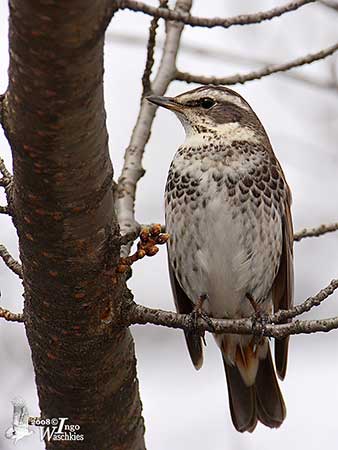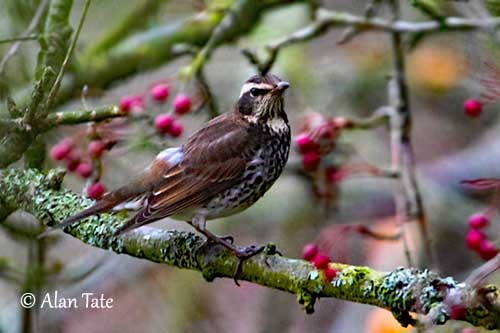
Fr: Grive à ailes rousses
Ang: Dusky Thrush
All: Rostflügeldrossel
Esp: Zorzal eunomo
Ita: Cesena fosca
Nd: Bruine Lijster
Sd: bruntrast
Photographers:
Didier Buysse
Vision d’Oiseaux
Alan & Ann Tate
AA Bird Photography
Ingo Waschkies
Bird Photography
Text by Nicole Bouglouan
Sources:
HANDBOOK OF THE BIRDS OF THE WORLD Vol 10 by Josep del Hoyo-Andrew Elliott-David Christie - Lynx Edicions - ISBN: 8487334725
THRUSHES by Peter Clement and Ren Hathway – HELM - ISBN: 0713639407
A Field Guide to the Birds of South-East Asia by Craig Robson. New Holland Publishers. ISBN: 9781780090498
BIRDS OF THE MIDDLE EAST by R.F. Porter, S. Christensen, P Schiermacker-Ansen C.Helm - ISBN: 0713670169
Wikipedia, the free encyclopaedia
What Bird-The ultimate Bird Guide (Mitchell Waite)
Dusky Thrush
Turdus eunomus
Passeriformes Order – Turdidae Family
INTRODUCTION:
The Dusky Thrush is now a full species, but formerly, it was treated as conspecific with Turdus naumanni. It breeds eastwards from central Siberia and winters south to Southeast Asia. It is a large Turdidae with brown back and rufous wings, and bold black-and-white head pattern. It typically feeds on insects, earthworms, berries and fruits, and forages on the ground. This species nests in trees but also near the ground in bushes.
The Dusky Thrush is described as common throughout the range, and the species is not globally threatened.

DESCRIPTION OF THE BIRD:
Biometrics:
Length: 23-25 cm
Weight: 62-88 g (Exhausted vagrants may weight only 44 to 57 g)
The Dusky Thrush adult male has dull greyish-brown crown and upperparts, with pale grey to whitish feather centres. The upperwing is bright rufous-chestnut. The tail is dark brown.
On the underparts, chin and throat are whitish, whereas breast and flanks are blackish with white scaly pattern. Belly and vent are off-white. We can see one or two black-flecked breast bands. Underwing-coverts and axillaries are rufous.
On the head, forehead and crown are like the upperparts. Ear-coverts and malar stripe are blackish and contrast strongly with white supercilium, submoustachial area, chin and throat. The lores are blackish.
The bill is blackish with yellow base of lower mandible. The eyes are dark brown. Legs and feet are blackish-brown.
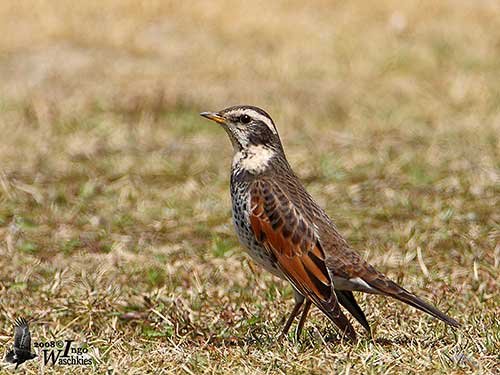
Male
Japan
The adult female resembles male but she is duller and browner above, including the head. She has less blackish coloration on ear-coverts, and less black on the breast. She has less or no rufous on the upperwing. The whitish chin and throat are more heavily spotted or slightly streaked. The malar stripe may appear more distinct.
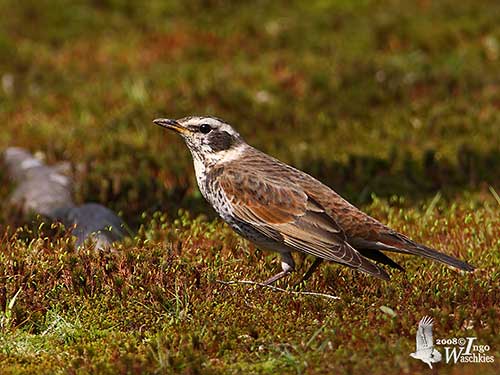
Female
Japan
The juvenile resembles adult, but it is extensively spotted buff above and blackish below. The breast band is absent. The 1st winter is like female, but it has blackish feather centres on much of the upperparts
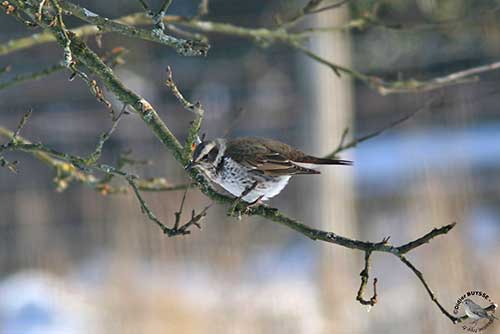
RANGE:
The Dusky Thrush breeds in NC and NE Siberia. It may occur in Alaska during the spring migration, but it is rare in coastal Alaska, along Aleutians and coastal British Columbia during the winter.
This species spends the winter from NE India E to N Vietnam, SE and E China, Taiwan, Korea and Japan.
HABITAT:
The Dusky Thrush breeds in open forests and woodlands, lowland tundra edges, dwarf willow thickets, but also poplar, birch, alder and coniferous woodlands and thickets, and in riverside scrub with tall trees. It often extends into montane areas.
This species spends the winter in sparse woodland, hillside scrub, open grasslands or with scattered trees, cultivated areas and even parks and gardens. It can be seen up to 3,000 metres of elevation.

CALLS AND SONGS: SOUNDS BY XENO-CANTO
The Dusky Thrush gives “srrii-i” in flight, recalling Redwing’s call. When the birds fly to the roost, they often utter strident “chek-chek-chek-chek”. Some subdued “chuck” notes can be heard when the bird is alarmed. It also produces a chattering “quaawag”.
Like most thrushes, the male has musical song, a series of loud, short phrases including melancholy sounds, soft whistles and dry trills. This song may be sustained like the songs of Common Nightingale, Songthrush and Common Blackbird “tryuuuu-tvee-tryu tyuu-trrryu-uute tryuute tryuute frrrrr”.
BEHAVIOUR IN THE WILD:
The Dusky Thrush feeds on insects and spiders, earthworms, berries, fruits and plant seeds. It forages mostly on the ground by hopping and walking over short distances, pausing frequently while searching for food.

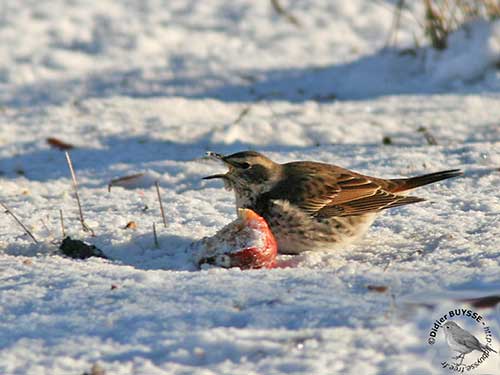
It is usually seen alone, but during migration and winter, it is often in small, loose flocks. They gather at roost or around abundant food sources.
The Dusky Thrush is territorial during the breeding season, and the species is probably monogamous. The male sings to proclaim and maintain its territory, and it may perform visual displays.
The courtship displays of this species are not described. Courtship feeding probably occurs. The female usually selects the nest-site and builds the cup-shaped nest, while the male remains in the vicinity, partly as mate-guarding behaviour.
The Dusky Thrush is strongly migratory. In addition to the usual wintering grounds, the species is vagrant in Europe, with sightings in Belgium (Erezée) and UK (Derbyshire), Middle East, Philippines and NW North America.
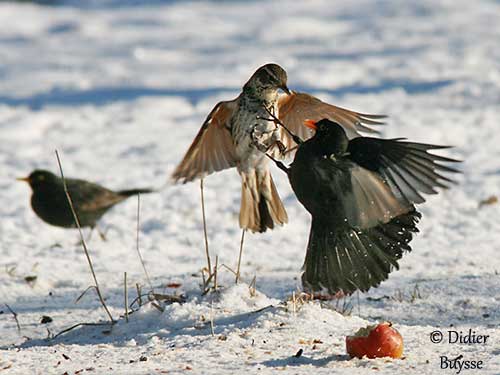
Erezée - Belgium
With Common Blackbird
The autumn migration occurs mainly in mid-September/mid-October, whereas the spring migration extends from mid-March to early May.
The Dusky Thrush has swift, direct flight with rapid wingbeats. Over short distances, the flight may become slightly undulating. The wings are fairly rounded.
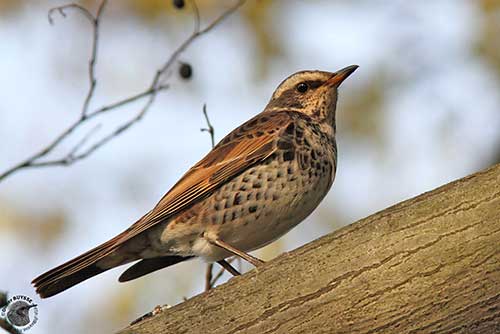
REPRODUCTION OF THIS SPECIES:
The breeding season takes place between May and June/August. The cup-shaped nest is made of grass, rootlets, twigs and moss. It is lined with mud and finer grasses. It is placed between 3 and 5 metres above the ground, but often below 1 metre in small tree or bush.
The female lays 4-6 greenish-blue eggs with dark markings. She incubates during 13-15 days. No other information.
PROTECTION / MENACES / STATUS:
The Dusky Thrush has wide range in which it is described as common. Like numerous species, it is threatened by modification of the habitat and local hunting, especially in China.
The size of the population is unknown, but the Dusky Thrush is not globally threatened and currently evaluated as Least Concern.
